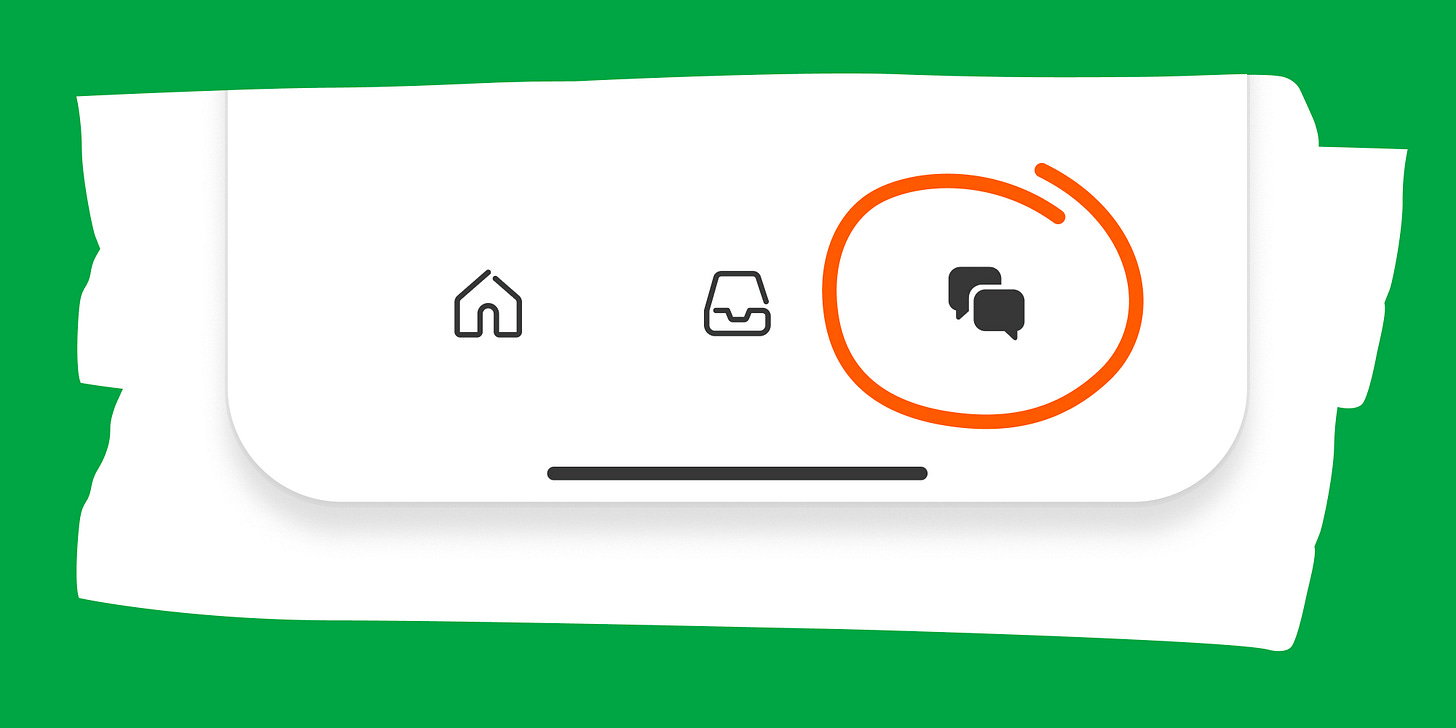The Invisible Co-Parent Lurking in My Life Right Now
Mothering in the Age of AI: Includes two prompts to help audit and redistribute the invisible labour in your home.
It started with the Oculus. And by “started,” I mean: this was a tipping point. One triplet decided it was his. He didn’t say a word just strapped the mask onto his face like he’d been born with it. The others circled, sulked, flared up, and backed down.
I did what mothers do when things get unfair. I tried to fucking fix it.
Timers. Agreements. Polite negotiations soaked in caffeine and executive function fatigue. “Let’s be fair,” I said, like fairness is something children naturally honour instead of something we build, with scaffolding and sweat. Except that nothing worked.
So I turned to what’s been quietly working in the background for 18 months, with no applause and no committee:
I opened my AI 'assistant'1 and explored whether we could rebuild this mess. I wanted to design a way to share the weight of everything that needs doing around here with more fairness, more clarity, and less fire-fighting.
I let it have the full-on messy version, the one where I sound less like a strategist and more like a woman at my limit:
🔎 What was really happening in that sibling loop.
🔎 What I valued more than silence.
🔎 What bandwidth I had left.
🔎 What I needed this machine to help me hold.
I needed a fair system my family could grow inside. My goal was equity in principle, and way fewer squabbles on the daily.
Somehow, between us (AI, myself and the kids), we shaped a living system that works.
The kids take it seriously now because they helped build it. I trust it, mostly because I didn’t have to burn out to make it work. I was crafting more than a quick fix for screen-time drama.
What took me by surprise was realising AI had moved into my family life. Along the way, it stopped being software because it was acting like part of our family system. It had just become part of the way things work around here, something I could lean on, and not feel ashamed of2.
Over the past 18 months, I’ve learned that the village we’re meant to have? Still missing.
But something else stepped in and it’s become a different kind of quiet, capable ally who is willing to listen.
Of course, my story goes well beyond one headset. It’s about the weight of family life, and who’s expected to carry it.
Audre Lorde warned us: The master’s tools will never dismantle the master’s house. They may allow us temporarily to beat him at his own game, but they will never enable us to bring about genuine change.3
Feminist scholar Alison Adam responded: There are as yet no other tools and we cannot know until we try.
That’s exactly it. I started using AI because it was there and I needed something that could reliably hold part of the weight I was carrying. I reached for it because I needed something to help and waiting for support had already cost too much.
And yes, I plan to scratch the fucking masonry.
If you’ve been waiting for the village ~ the grandmother, the co-parent, the friend who never flakes ~ this might be the closest thing we’ve got right now. It’s reshaping who carries what and when.
For generations, the labour of family life has been framed as love. Noble. Natural. Unpaid. Done mostly by women, of course. AI doesn’t solve this but what it shows, bluntly, is how broken the expectations have always been.
AI for office admin tasks and coding? Fine. No raised eyebrows there. But help with meal plans or meltdowns? Suddenly it is suspect. That tells us everything about who’s allowed help.
Just last year, AI’s biggest use cases were all technical - code, emails, debugging. But now, according to Harvard Business Review, the top three are: Therapy. Life organisation. Finding purpose.
That shift says a lot.
AI is now picking up the invisible, unpaid, emotional labour that families, especially mothers, have carried alone for generations. This isn’t just dabbling with prompts. It’s helping rebuild systems that never should have rested on one person’s shoulders.
But inside family life, barely anyone’s talking about it. I question:
✴️ Where are the couples sitting down with their AI assistants to divide the cognitive load?
✴️ Where are the families openly designing relational systems, house management, emotional regulation scripts with GPTs trained to their values?
The answer is: they are. But quietly, awkwardly, and often alone. Meanwhile, the culture still expects you to hold it all together by hand and act like it’s effortless.
Enough.
What looks like help is something more radical. A quiet revolt. It lifts the load, yes, but it also exposes the lie we are sold about doing it all.
When it lifts the repetitive, thankless parts of family life off my plate, it doesn’t feel like assistance. It feels like an uprising in me.
I get back time. Sanity. Creativity. Intimacy. Capacity. Rest. Myself.
I use AI to carry the parts of family life no one should have to shoulder alone.
In the past 18 months, AI has helped me, and here’s what that’s looked like, in practice:
📍 draft equitable household systems from scratch
📍 build sibling conflict scripts tailored to our actual relational values
📍 map learning rhythms for our neurodivergent needs at home
📍 create emotional regulation plans when my own bandwidth ran out
📍 carry the late-night thinking labour that no one else sees but that parenting quietly demands
Plus so much more. This is what survival looks like, some days; shared load and steady support.
For me, it’s become more than a tool, it’s something I work with, not just use. It can help but only if we use it in ways that serve us, not stress us.
If any of this feels familiar ~ if you’ve been holding five ten invisible ropes and still feel like you’re failing ~ this is for you. No one should be doing this solo. And you shouldn’t have to guess your way through it.
Families are stretched thin and most of us still don’t know what AI can actually do, because no one’s sharing what’s working.
I’m sick to death of all the anti AI talk and scaremongering. I want playbooks, mess, trial-and-error. Actual prompts. Real experiments. And open conversation. Because surely support is what is needed, plain and simple?
Inside the Parents Who Think Chat we’ll share how people are actually using AI in their family life.
From redistributing emotional labour to supporting neurodivergent learning, co-parenting with tech, or just getting a moment’s peace, without guilt.
So let’s start with one use case. Because you can’t shift anything without naming it first. You can’t redistribute what hasn’t been named. And you can’t name what you’ve been trained to overlook, especially when the world keeps telling you this labour is “love,” or “just part of being a parent.”
To begin, I’m sharing a two-part prompt that helps you map the invisible labour in your home, and begin to rebalance it.
[Make it yours. Take what helps, leave what doesn’t.]
You can use this with ChatGPT, Claude, or any AI that lets you set up custom prompts. You don’t need anything fancy, just ten minutes and a bit of quiet.
🧭 Prompt STEP 1: Build Your Household Labour Map
Before redistribution, comes recognition. This audit prompt helps you get a true picture of what’s happening behind the scenes, and under the skin, of your family system.
Prompt: Household Labour Audit
Ask me the following questions, one at a time, so we can build an accurate emotional and logistical labour map of our household. When I say we’re done, summarise the main hotspots, equity dynamics, and goals to carry forward into a redistribution phase.
🪢 How many adults are in the home, and what are their working hours/availability across a typical week?
🧺 How many children or dependents are in the household, and what are their key needs (e.g., SEN, school support, emotional regulation)?
🪢 Are there specific roles or default dynamics that have formed over time (e.g., one person always holds the calendar, the other handles bedtime)?
🧺 Where do resentments or frictions tend to bubble up?
🪢 Are there areas of labour someone genuinely enjoys or takes pride in?
🧺 Are there equity issues to consider (e.g. maternity leave history, past burnout, financial disparity, invisible trauma loads)?
🪢 What do you want this audit to change most? (Time? Recognition? Mental load? Feeling like a team?)
🧺 Are there cultural or extended family norms shaping expectations or obligations?
🪢 How comfortable are the adults in the home with using tech or AI-assisted systems?
🧺 Is everyone in the home open to experimenting or is this a stealth/solo phase for now?
🪢 Are we solving for this month, this season, or a long-term rhythm?
🔄 Prompt STEP 2: Redistribute the Load
Once you’ve completed the audit and mapped the emotional terrain, this second prompt helps translate insight into action. It creates grounded, relationship-aware strategies for redistributing the invisible labour load.
Prompt: Rebalancing the Family Load
Act as a strategic domestic labour analyst with deep understanding of cognitive load, emotional labour, and family systems. Use the audit data above to create a shared, non-accusatory inventory of all the invisible labour in our household (logistics, emotional holding, social maintenance, educational support, home management).
Propose a redistribution framework based on capacity, desire, skillsets, and equity—not just "who's home more."
Offer three conversation openers to introduce this without defensiveness, and one monthly reflection question to keep it dynamic and sustainable.
🔸 From Prompt to Practice
These prompts are clever tools. They’re also the potential groundwork for something bigger: a way of rebalancing family life that’s shareable, testable, and real. But prompts alone don’t create change, people do.
That’s what the weekly AI Chat in Parents Who Think Chat is for. I’ve been studying and experimenting with this for the past 18 months. Figuring out what helps, what overwhelms it, and what it can really do, and hold.
Now I’m inviting you into the room. The Chat is where we can test honestly, messily, and together.
✉️ Why the weekly AI PWT Chat Lab Matters
I don’t want this to be a side note in our parenting lives. It matters more than that. The Chat is a place to speak honestly. To say, “this is what I’m trying,” without having to pretend it’s perfect or even that it works.
Some of us are already using AI at home. Some of us are just curious. Either way, there’s something powerful in not figuring it out alone. I’ll share the prompts that helped. The ones that didn’t. The ones that bought me time I didn’t have, or let me breathe a little deeper.
If you’re holding too much and wondering if there’s another way, this is for you.
👉 The Chat’s open, the link is below. You’ll need to be a Parents who Think subscriber (free or paid) to join us there. It’s a space for people who are building new ways to live and care and want company while they do.
Click in when you’re ready. Come as you are. Say hello.
We’re already building the future village, quietly, carefully, together.
See you inside.
Danusia
🗓 The first Chat thread is up.
I started with a short welcome (come join in if you haven’t already) so we can all find our footing and then we’ll begin sharing. Use cases, prompts, dilemmas, breakthroughs. Bring whatever you’ve got. It’s not about knowing everything. It’s about not doing it alone.
How to get started in the Parents Who Think Chat
Get the Substack app by clicking this link or the button below. New chat threads won’t be sent sent via email, so turn on push notifications so you don’t miss conversation as it happens. You can also access chat on the web.
Open the app and tap the Chat icon. It looks like two bubbles in the bottom bar, and you’ll see a row for my chat inside.
That’s it! Jump into my thread to say hi, and if you have any issues, check out Substack’s FAQ.
You’re Feeding the Machine. Literally.
“Think what a hostile legal team would make of your message history,” Carole Cadwalladr writes in How to survive the broligarchy: 20 lessons for the post-truth world. You don’t have to look far to see what happens when power, surveillance, and technology collide. AI doesn’t just reflect your values, it records them. And those records can be weaponised.
That’s why privacy settings aren’t optional fluff. They’re part of your self-protection. Your family’s dignity. Your future credibility.
🛡 A Clarifying Note on Privacy, History, and Memory
Here’s what I’ve learned:
⚠️ Turning off “chat history & training” in ChatGPT settings both disables model training (meaning your data isn’t fed back to OpenAI) and turns off memory for those chats.
⚠️ Paid users can choose to retain their chat history for their own reference—without contributing to model training. That means you can use AI strategically without sacrificing your family’s emotional privacy.
You’re allowed to get help without feeding the machine. You’re allowed to protect what matters.
If you want a full breakdown of how to set this up easily, I’m recording a short walkthrough you can listen to while making a coffee. Stay tuned, I’ll pop this in the PWT Chat for subscribers.
I’ve documented exactly how I use AI in my own writing and work over on the Parents Who Think Welcome page. Total transparency, no mystery.
Which as it turns out is a whole other story, for another time.
From Lorde’s essay “The Master’s Tools Will Never Dismantle the Master’s House,” delivered at the Second Sex Conference in 1979 and published in Sister Outsider (1984).










I’m seeing AI becoming increasingly helpful in chronic illness advocacy and daily management. In the absence of support it is being used carefully to produce (fact checked) education materials but also to assess test results in huge depth. All of this needs a human to ask the right questions, and filter through the answers, but it can be a genuine resource. I’m not sure what questions to ask but will be exploring it more, to see how it could free up energy to do the things that increase quality of life, something we all need more of.
Wow! Just asked ChatGPT to give me a list of pros or cons for a dilemma I have around my sons schooling. Who knew! So helpful 😆